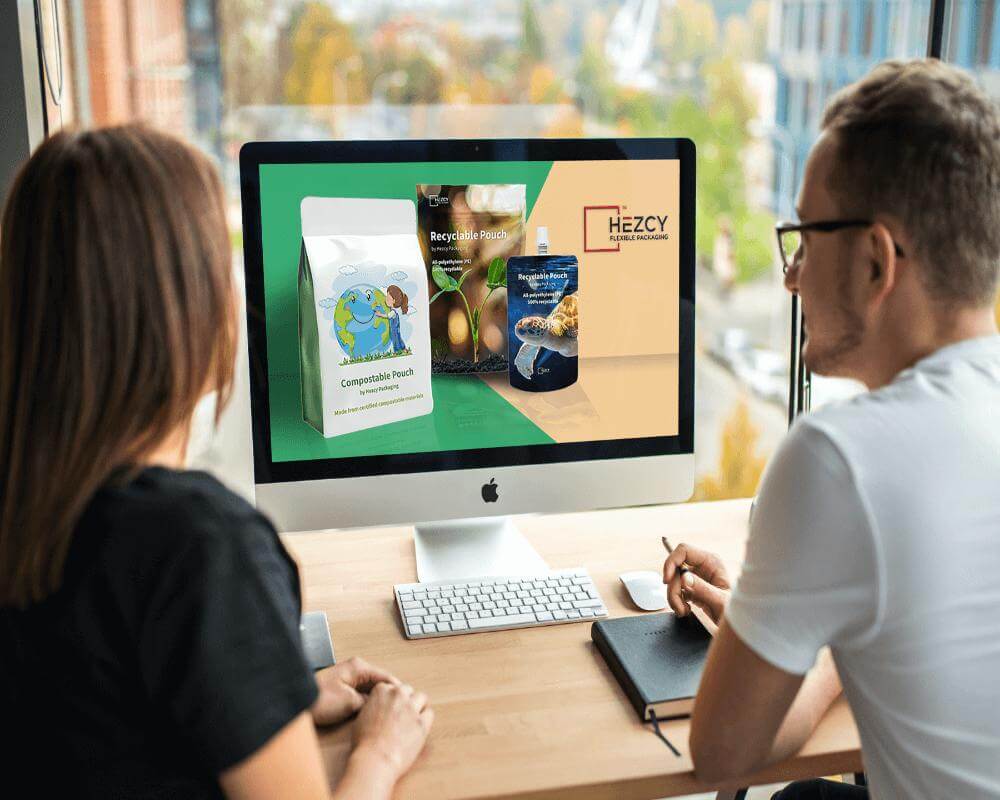A stand-up pouch refers to a flexible package whose bottom can be displayed, stored and used upright. In this guide, you will learn many aspects of the stand-up pouch manufacturing process and other relevant details.
1. Determine the purpose of the stand-up pouch
The first step in the stand-up pouch manufacturing process is to determine its actual use. Essentially, this involves figuring out the exact purpose, whether it is designed to preserve, protect or store a particular product.
The stand-up pouch structure is easy to figure out once the actual intent has been determined. Ideally, figuring out the actual intent of this packaging component allows you to identify the correct material for the content.
In addition, you will determine the correct design, size and shape of the stand-up pouches you make.
2. Design Process
Once the specific purpose of the stand-up pouch has been determined, the next step is to create a conceptual design. Essentially, this involves using a compatible software program to draw and virtually represent the package.
This process is often complex as it requires a better understanding of how to use design software to generate the desired design. However, during the design process, it must be understood that there is a limit to what a pouch can hold.
Therefore, it can easily determine several factors during the design process, such as quantity, quality and shape. It is also during the design process that you will decide whether to incorporate zipper locks, spouts, push-to-close seals or tear notches.
Usually, in this case, the choice depends on the specific nature of the contents you plan to put in the stand-up pouch. This is necessary as it determines the efficiency with which the contents are removed from the stand-up pouch.
Additionally, this allows you to easily determine whether you need a flexible stand-up pouch or a rigid stand-up pouch. For example, when designing such a pouch for liquid contents, it would be appropriate to consider creating a stand-up pouch with a spout rather than a self-sealing pouch.
Also, consider the target market during the design process by ensuring that the package is customized to meet the requirements and expectations of the client. It also allows you to determine the general capital and ROI of the product.

3. Find the right material for your stand-up pouch
In terms of practicality and efficiency, the material you choose for your stand-up pouch is crucial. Essentially, a typical stand-up pouch has a different material construction.
These material structures are specifically designed to protect the contents from a number of factors including odor, moisture, oxidation, light or a combination of all factors.
You can find a variety of stand-up pouch material alternatives. Some common options include aluminum foil construction, metalized film construction, cookable construction, kraft paper film construction, microwave construction, and more.
A stand-up pouch’s most suitable material depends on its characteristics, the product, and the customer’s preferences. For example, aluminum foil is commonly used in stand-up pouches designed to provide a moisture and oxygen barrier.
On the other hand, polymers are preferred when the application requires mechanical strength, heat sealing, water vapor barrier, adhesion and stiffness.
Generally, a typical stand-up pouch consists of three main layers; an inner layer, a middle layer and an outer layer. All of these layers use different materials and are usually laminated together to form a single layer.
1) Inner layer material
It forms the integral basis of the stand-up pouch as it is the part that comes into direct contact with the contents. Therefore, it is seen as a vital layer, especially when the pouches are used to package food and beverage products.
Generally, the ideal material for the inner layer is linear low-density polyethylene (LLDPE). In addition to being an FDA-approved material, it helps heat seal the pouch easily and makes the product difficult to tamper with. Ideally, this is fundamental, as it improves the shelf life of the product and the confidence of the customer when purchasing the item.
2) Middle-layer material
The material type of the middle layer of the stand-up pouch usually varies according to the specific content of the pouch. Essentially, you can use a variety of materials to make this layer.
However, options that are generally preferred in most applications include metalized film, aluminum foil, and polyethylene terephthalate (PTE/PETE).
In terms of durability, these materials have different structural capabilities. The metalized film, for example, is ideal for relatively fast-moving products because it has a slightly shorter lifetime.
On the other hand, aluminum foil is more durable than a metalized film as it can preserve the product for at least 20 months. PTE/PETE is also a suitable interlayer material, most suitable for stand-up pouches for packaging personal care products.
3) Outer material
It is the layer of actual finish material that, in many cases, is designed to attract the attention of the client. In addition, the material contains detailed information on other elements of the product and brand information.
Generally, kraft paper is usually used as the most suitable outer material for stand-up pouches. It is natural and environmentally friendly, so it is an ideal choice.
Furthermore, it enhances the aesthetics of the pouch, in addition to the durability, strength, and quality attributes it provides. All these material structures are integrated and laminated using dedicated technologies.
You’ll barely notice if the material is made from three distinct layers, as the result is seamless.

4. Choose the right stand-up pouch design
In general, choosing the right stand-up pouch design depends largely on the specific content you plan to pack into it. In addition, determining the target market is also an important factor in selecting the actual design of the component.
For example, whether you choose a spout, cap, zipper lock, push-to-open seal, or tear spout depends on the product and, in some cases, customer preference.
Liquid and semi-liquid contents would be ideal if packaged in a stand-up pouch with a lid or spout.
Technically, the pouch design makes it easy for consumers to completely empty the contents of the pouch. When designing a typical stand-up pouch, it is imperative to ensure that it meets the specific requirements of your target audience.
Customization is also crucial to making sure your products stand out in a competitive market, as customers can easily spot them on crowded shelves.
Another important aspect of designing a stand-up pouch is determining the correct shape and size. Most customers will only notice the product easily if the packaging is unique.
You might also consider incorporating a euro slot on the top of the pouch for easy hanging on a hook display. In essence, built-in holes are easy to please customers; therefore, most retailers want to have as many options for merchandising as possible. The bottom line is to make it easy for customers to open the package and empty the contents easily.
Also, depending on the product, you will need to design the stand-up pouch in a way that allows the customer to retain the contents for later use. Therefore, the pouch should have a self-locking or push-to-close seal to be able to securely close the contents for later use.

5. Make the stand-up pouch
You can print any logo, color, and design on the material during the manufacturing process of stand-up pouches.
Ideally, without these gussets, the stand-up pouch can barely stand on its own. If the pouch is going to have a zipper, seal it on the inside surface of the mesh near the top edge.
Besides zippers, you can also use perforations, spouts, press release seals, or tear-offs as access methods. Once the gusset is formed, a vertical seal is formed along the side of the pouch and a self-seal is pressed in the same area.
The essence is to seal its ends and reduce the material thickness. Then, cut the bottom crease of the pouch vertically through the center of the side seal to form the container portion of the pouch.
When the bottom of the pouch is folded to seal, the seals at the ends that hold the gussets together are also sealed. In order to form the pouch’s container portion, the stand-up pouch is cut vertically through the center of the side seal.
It is then conveyed to the station where the pouches will be filled with specific contents. Once the contents are dispensed into the stand-up pouches, it is conveyed to another processing station where the zipper lock is closed and the pouch is resealed over the zipper.
Typically, a notch is usually cut into the side of a stand up pouch, especially where the ziplock pouch and top seal are located.
This enables customers to easily open the pouch and empty the contents.

6. Stand-up pouch quality test
The production process of the stand-up pouch is fully industrialized and advanced equipment is used. Since these pouches play a vital role in the packaging of different products, several tests are usually carried out to determine their suitability and quality.
In addition, these tests are designed to verify the reliability of stand-up pouches under various environmental and mechanical conditions. Among these quality tests are the following:
- Tensile test – This check is performed on a stand-up pouch to determine how far the material can stretch and the amount of pressure required to break it.
- Drop test – In this quality test, the goal is to determine the ideal height at which a stand-up pouch can be dropped without breaking.
- Burst test – designed to check the maximum pressure at which the stand-up pouch bursts.
- Coefficient and friction testing – check and verify the seamlessness of film packaging.
- Compression test – The purpose of this test is to determine the air pressure that a stand-up pouch can withstand.
- Stand-up pouch puncture resistance test – Determines how much pressure is required to puncture the flexible packaging material.
- Test of seal strength – This test determines how well a stand-up pouch seals and how well it keeps the pouch closed.
- Under external vacuum pressure, this quality test determines whether the stand-up pouch will leak.
Essentially, a stand-up pouch needs to meet a specific level of these tests in order to be declared fit, safe, and of the required quality.
Reputable manufacturers of stand-up pouches have well-equipped laboratories and qualified personnel to handle all related quality tests.





Leave A Comment